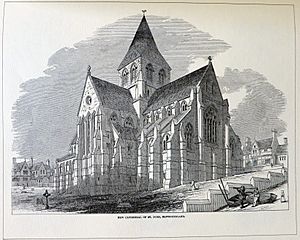Cathedral of St. John the Baptist (St. John's) facts for kids
Quick facts for kids Cathedral of St. John the Baptist |
|
|---|---|
 |
|
| 47°33′56″N 52°42′30″W / 47.5655°N 52.7082°W | |
| Country | Canada |
| Denomination | Anglican |
| Churchmanship | Central churchmanship |
| History | |
| Status | Cathedral |
| Founded | 1847 |
| Founder(s) | Edward Feild |
| Dedication | John the Baptist |
| Events | Great Fire of 1892 |
| Architecture | |
| Functional status | Active |
| Architect(s) |
|
| Architectural type | Cathedral |
| Style | Gothic Revival |
| Years built | 1847 – 1905 |
| Specifications | |
| Length | 200 feet (61 m) |
| Nave width | 60 feet (18 m) |
| Width across transepts | 99 feet (30 m) |
| Height | 80 feet (24 m) |
| Nave height | 57 feet (17 m) |
| Administration | |
| Parish | Cathedral Parish of St John's |
| Diocese | Eastern Newfoundland and Labrador |
The Cathedral of St. John the Baptist is an Anglican church in St. John's, Canada. It is a very important church for Anglicans in Newfoundland and Labrador. People often call it the "mother church" for the area.
This cathedral is also the main church for the Bishops of Eastern Newfoundland and Labrador. A bishop is a leader in the church. The current bishop is Sam Rose, who has been in this role since 2020.
The Anglican church community in St. John's started way back in 1699. People in the town asked the Bishop of London for help. They also wanted to rebuild their church. Their old church had been destroyed in 1696 by the French army.
Over many years, several wooden churches stood on or near this spot. Each one was destroyed during wars between the French and the British. Eventually, the British took control of eastern North America.
Building the Cathedral
The first stone church began construction in 1843. This was under the guidance of Aubrey Spencer, who was the first Bishop of Newfoundland and Bermuda. Not much was built before Spencer had to leave due to poor health. This stone church was later destroyed in a big fire in 1846.
The cathedral you see today started being built in 1847. This was led by Edward Feild, the second Bishop of Newfoundland and Bermuda. Bishop Feild asked a famous architect, George Gilbert Scott, to design the church. Scott imagined a grand church shaped like a cross. It would have beautiful decorations in a 12th-century English style.
The main part of the church, called the nave, was built between 1847 and 1850. For 35 years, this part served as the entire cathedral. Scott's helper, architect William Hay, watched over the building of the nave.
Work on the choir and transept sections began later, in 1880. These parts were finished in September 1885. This work was overseen by Bishop James Kelly. Adding these sections made the cathedral look like a Latin cross. This style of building, called Gothic Revival architecture, was popular for churches in Newfoundland during the 1800s.
The Great Fire of 1892
On July 8, 1892, a terrible event happened. The cathedral was badly damaged in the Great Fire of 1892. The roof caught fire and collapsed. This caused the walls and pillars in the nave to fall too. The intense heat melted the lead in the stained-glass windows. All but two windows were completely destroyed. The only window that survived can still be seen in the Sacristy.
Restoration of the Cathedral started in 1893, again led by Bishop Kelly. By 1895, the Chancel (the area around the altar) and Transepts (the arms of the cross shape) were rebuilt. The Nave was finally finished in 1905. The restored cathedral is known around the world as one of the best Gothic Revival buildings in North America. The church was officially opened again in a special service on September 21, 1905. A window in the restored Cathedral was dedicated to Bishop Kelly, who passed away in 1907.
In 1923, a father and son, Mahomet Thomas Phillips and Lancelot, created a beautiful carved screen for the cathedral. It took them 2,779 hours to make! In 1952, a special window called the Te Deum Window was given to the church. It was a gift from the family of Sir Joseph Outerbridge. A large organ with four keyboards was built by Casavant Frères in 1927.
Cathedral Design and Features
The Cathedral is 200 feet (61 m) long from the main entrance to the Sanctuary. The main part of the church, the nave, is 60-foot (18 m) wide. At its widest point, where the transepts are, it measures 99 feet (30 m). Inside, where the nave and transept meet, the ceiling is 57 feet (17 m) high. Outside, the roof reaches 80 feet (24 m) at its highest point.
The cathedral is still not fully complete. It does not have the tall spire that its original designer, George Gilbert Scott, had planned. Engineers have checked, and they say a 150-foot (46 m) tower and steeple could be built. However, it would cost a lot of money, around $3,000,000. The people of the Cathedral Parish do not have plans to add the spire right now.
The cathedral was named a National Historic Site of Canada in 1979. This means it is a very important example of Gothic Revival architecture in the country. It was also recognized as a Registered Heritage Structure in 1991 and a City of St. John's Heritage Building in 1989.
See also
- Architecture of St. John's
- Diocese of Eastern Newfoundland and Labrador



